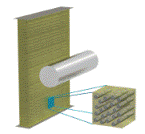Mechanical and Materials Engineering, Department of

Department of Engineering Mechanics: Dissertations, Theses, and Student Research
Date of this Version
12-2010
Document Type
Thesis
Abstract
Glassy polymers such as polycarbonate (PC) can be toughened through compressive plastic deformation. The increase in toughness is substantial, showing as much as a fifteen fold increase in the amount of dissipated energy during failure for samples compressed to 50% plastic strain. This toughness increase can be reversed through thermal aging at temperatures below the glass transition temperature (Tg = 147°C).
The combined effect of plastic compression and thermal aging has been studied using Charpy, Single Edge Notch Bending (SENB), and Compact Tension (CT) tests. The tests mapped the response of samples cut along different orientations relative to the plastic compression as a function of plastic compression, thermal aging temperature and aging time. The Charpy and SENB tests were conducted on as received samples of PC that were 0%, 25% and 50% plastically compressed. The CT tests were done on annealed and quenched samples that were then compressed up to 35%. The Charpy samples were aged at isothermal temperatures between 105°C and 135°C. The SENB samples were aged at 105°C and 125°C. The CT samples were aged at 125°C. All samples were tested at room temperature. Three modes of failure were observed for the fracture surfaces, a low energy dissipation brittle fracture, high energy dissipation ductile fracture, and a mixed mode intermediate fracture. Toughening through plastic compression changed the failure mode of the PC from an initial low energy dissipation brittle fracture to an intermediate or high energy dissipation failure. Thermal aging reversed this process in some cases. This effect was mapped as a function of sample orientation, aging temperature and aging time.
The dynamic Charpy test results were supported by the quasi-static SENB and CT results. The CT samples were small enough to provided samples in the third orientation, which had cracks propagating orthogonal to the direction of compression with crack surfaces that had a normal along the direction of compression. These samples failed with extremely low energy dissipation indicating that even though the compression improved the energy dissipation along the other two directions substantially (i.e., 5 to 15 times), it also resulted in a “weak” orientation.
Included in
Engineering Mechanics Commons, Mechanical Engineering Commons, Mechanics of Materials Commons


Comments
A thesis Presented to the Faculty of The Graduate College at the University of Nebraska In Partial Fulfillment of Requirements For the Degree of Master of Science, Major: Engineering Mechanics, Under the Supervision of Professor Mehrdad Negahban and Professor Joseph Turner. Lincoln, Nebraska: December, 2010
Copyright 2010 Shawn E. Meagher